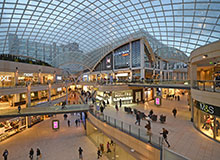Long-term success for retail parks depends on a progressive approach to asset management. Investors with exposure to out-of town retail know its potential to deliver strong returns.
Healthy demand from occupiers for space at prime sites, complemented by a planning-led undersupply, is clearly a favourable dynamic. However, investors cannot rely on this to drive returns indefinitely. They need to invest for the long term to maximise the potential of the assets they manage.
The role of an active manager first and foremost is to work with retailers to provide high-quality destinations for customers. We know success comes from ensuring that schemes deliver, not just in the experience they offer, but in the way they meet the demands of 21st-century shoppers across a range of physical and online platforms. Adding floor space to bring in new tenants, incorporating leisure uses such as restaurants and cafés, and investing to create attractive and accessible public spaces all elevate assets from functional shopping locations to places that people want to visit. Similarly, investors who incorporate the latest multi-platform trends into their parks will reap the rewards. Click and collect, for example, offers a fantastic opportunity for retail parks to appeal to the web-savvy generation of consumers.
However, creating world-class retail destinations is only one part of a much wider picture. Consumers are increasingly making choices based not just on the quality of a product, but also on how businesses are run and the values they stand for. For property owners and occupiers, this means long-term success is linked with the sustainability of their operations. This is especially the case for out-of-town retail, which some commentators are quick to label as unsustainable, citing its dependence on car travel, the perceived impact these schemes have on the high street and their poor energy efficiency.
There is fantastic potential for the out-of-town sector to prove these commentators wrong, though there is still a long way to go. For example, great progress can be made at a scheme’s design stage by ensuring that the next generation of retail parks are built to a much higher environmental standard than the current stock. Our in Milton Keynes, for example, is the first in the UK to receive a BREEAM Excellent rating. For existing parks, solar PV, cycling facilities, promoting car-sharing schemes and using open space for biodiversity ?projects are all initiatives we are exploring.
As important as addressing environmental challenges is working to embed retail parks as assets in local communities, challenging the idea that parks detract from community cohesion. Out-of-town is not the architect of the troubles facing local high streets. This is down to long-term trends in the consumer and occupier markets. However, the retail park sector can learn a lot from the high street, especially about how destinations can contribute positively to local communities. We are looking at how to adopt some of these principles, for example, by creating space in parks for community hubs and by engaging local schools and community groups across the portfolio.
The relationship between occupiers and owners is at the heart of a successful, sustainable retail park sector. The Crown benefits from a critical mass that enables us to establish successful relationships with retailers. These relationships also mean that we can work with our tenants to explore how things like on-site renewables or community initiatives could benefit our businesses, the local area and the sustainability of the sector.
A progressive approach to sustainability is at the core of our business – whether it’s installing the UK’s first molten carbonate fuel cell in one of our central London schemes, supporting renewable energy offshore, or adopting a forward-thinking approach to out-of-town retail.
Paul Clark is director of investment and assett management for the Crown Estate











